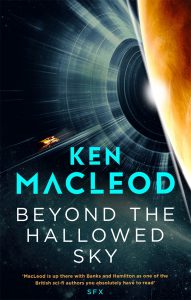Russell Letson Reviews Beyond the Hallowed Sky by Ken MacLeod

Beyond the Hallowed Sky, Ken MacLeod (Orbit 978-0-356-51479-6, £8.99, 336pp, pb) November 2021. Cover by Duncan Spilling.
Ken MacLeod has long been deploying a useful kind of what-iffery, in which the futures he depicts are not ours but alternate futures, branched off from crucial events in our past – a strategy that powers the Fall Revolution and Engines of Light sequences. It’s a useful way of generating scenarios that would be unlikely or impossible from our own actual situation – and also for future-proofing stories against the kind of plot-ruining news developments that have bedeviled Charles Stross and required mid-course re-writes. (Stross solved this problem in the Merchant Princes/Empire Games books via an explicit many-worlds framework.)
MacLeod has devised a compelling new alternate future in Beyond the Hallowed Sky, the first book of the Lightspeed Trilogy. The relevance of the series title would seem to be rooted in the first chapter: in 2067, physics doctoral student Lakshmi Nayak receives a letter in her own handwriting that she cannot have written, postmarked from a place she has never been, with equations she has not devised, suggesting a radical reworking of physics: that faster-than-light travel is possible. Three major plot threads then spin out from the year 2070. On the extrasolar planet called Apis, Emma Hazeldene returns to duty aboard a starship adapted from a nuclear submarine design. On Earth, near Scotland’s Clydeside shipyards, John Grant watches a submarine levitate from the waters of the Firth and vanish in ‘‘a blue flash.’’ And on Cloud City, a research station suspended in the soupy atmosphere of Venus, the very humanoid robot calling himself Marcus Owen is uncrated and begins his open-secret job as cultural attaché/intelligence agent.
We are dropped into this world with minimal expository-explanatory material and left to pick up clues about socio-economic systems, global politics, and technological advances that could not have originated in our timeline. Lakshmi Nayak’s sky is filled with airships, and her defection to a rival polity offers glimpses of reshuffled world power structures. Emma Hazeldene has worked for 15 years on Apis, where a super-secret interstellar exploration project was already operational for decades before her recruitment. John Grant is a veteran of the decades-earlier Rising, one of the political upheavals and insurrections that realigned the world into three rival blocs: the Euro-Scottish-Irish Union, the ‘‘Anglosphere’’ Alliance, and the Russo-Chinese Co-ordinated States. Clearly a lot of history has been rearranged, and Lakshmi’s mysterious letter suggests that something wonky is going on with time itself.
These three story lines, each labeled with a place and time to keep them distinct, gallop along, and each one exploits one or more distinct SF subgenres. On Earth, Grant and some shipyard co-workers put Lakshmi’s theories into practice in a man-who-sold-the-moon scenario – or, to be precise, a revolutionary-collective-that-built-an-unsanctioned-starship adventure. Grant’s memories of the Rising that formed the Union – and his continuing role in its Cold Revolution – outline a sociopolitical system of ‘‘economic democracy’’ familiar from earlier MacLeod projects mixing old-left and libertarian notions. On Venus, Owen pursues a complicated solo operation targeting certain Cloud City projects, working without the limits of human physical frailty or the restraints of pesky Asimovian Laws. On Apis, Emma encounters human exiles, the descendants of unofficial (and sometimes involuntary) colonists, as well as a very strange and powerful form of alien intelligence whose emphatic advice is ‘‘GO AWAY.’’ On all three worlds, relics of the deep galactic past are being discovered and prodded into dangerous wakefulness. These plotlines, of course, converge in ways that resolve one set of conflicts and answer one set of questions, while setting the stage for the next – the last page is a pause, not a finale.
So we have the pleasures of the intrigue thriller, of First Contact, of the mysteries of ancient and godlike intelligences, of planetary pioneering, of socio-politico-economic speculation, of the possibilities of artificial intelligence, and of the various plot chases. In that last department, Owen is a particularly resilient antihero, cheerfully amoral (he’s not programmed for morality, though he does seem to be able to simulate a sense of humor) and endlessly inventive and persistent in carrying out his mission, which provides the impetus for the big set-piece special-effects sequence at the book’s finish. It’s a dense, busy mix, the kind of story that has the reader (well, this reader) backtracking to trace and assemble the connections among motifs and the scattered pieces of political thought. And because this is only the first third of a longer work, I was also tagging the unanswered questions, the teases, and the connecters for developments yet to come. The strenuous fun has just begun.
This review and more like it in the February 2022 issue of Locus.
 While you are here, please take a moment to support Locus with a one-time or recurring donation. We rely on reader donations to keep the magazine and site going, and would like to keep the site paywall free, but WE NEED YOUR FINANCIAL SUPPORT to continue quality coverage of the science fiction and fantasy field.
While you are here, please take a moment to support Locus with a one-time or recurring donation. We rely on reader donations to keep the magazine and site going, and would like to keep the site paywall free, but WE NEED YOUR FINANCIAL SUPPORT to continue quality coverage of the science fiction and fantasy field.
©Locus Magazine. Copyrighted material may not be republished without permission of LSFF.







